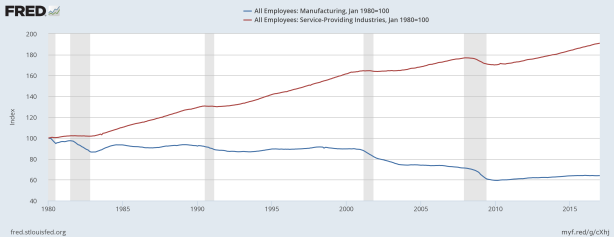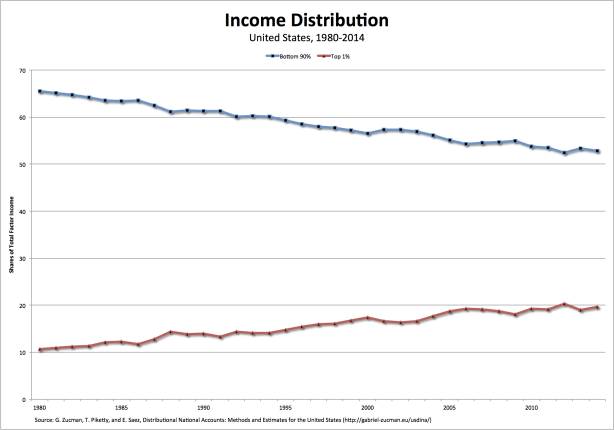From David Ruccio It’s true (as I have argued many times on this blog), the number of U.S. manufacturing jobs has been declining for decades now—and they’re not coming back. Instead, they’ve been replaced (as is clear in the chart above) by service-sector jobs. source And, not surprisingly, most new jobs (during the past year, as in recent decades) have appeared in urban centers. But the idea that service-sector job growth in some urban centers—or “brain hubs,” as The Geography of Jobs Enrico Moretti likes to call them—is going to solve the problem of the growing gap between haves and have-nots is simply wrong. Moretti (and, with him, Noah Smith) would have us believe that everyone in the one America that is “healthy, rich and growing” (as against the other America, which is “increasingly being left behind”) stands to benefit. And they don’t need manufacturing jobs to do so. But looking at the wages of those workers in the local service jobs celebrated by Moretti and Smith tells a very different story. Here they are, from the Bureau of Labor Statistics: OCCUPATION MEDIAN HOURLY WAGE Teachers .70 Registered Nurses .45 Licensed Practical Nurses .76 Carpenters .24 Taxi Drivers .30 So, no, the growth of local service jobs in so-called brain hubs is not going to solve the problem of inequality that plagues the United States.
Topics:
David F. Ruccio considers the following as important: Uncategorized
This could be interesting, too:
tom writes The Ukraine war and Europe’s deepening march of folly
Stavros Mavroudeas writes CfP of Marxist Macroeconomic Modelling workgroup – 18th WAPE Forum, Istanbul August 6-8, 2025
Lars Pålsson Syll writes The pretence-of-knowledge syndrome
Dean Baker writes Crypto and Donald Trump’s strategic baseball card reserve
from David Ruccio
It’s true (as I have argued many times on this blog), the number of U.S. manufacturing jobs has been declining for decades now—and they’re not coming back. Instead, they’ve been replaced (as is clear in the chart above) by service-sector jobs.
And, not surprisingly, most new jobs (during the past year, as in recent decades) have appeared in urban centers.
But the idea that service-sector job growth in some urban centers—or “brain hubs,” as The Geography of Jobs Enrico Moretti likes to call them—is going to solve the problem of the growing gap between haves and have-nots is simply wrong.
Moretti (and, with him, Noah Smith) would have us believe that everyone in the one America that is “healthy, rich and growing” (as against the other America, which is “increasingly being left behind”) stands to benefit. And they don’t need manufacturing jobs to do so.
But looking at the wages of those workers in the local service jobs celebrated by Moretti and Smith tells a very different story. Here they are, from the Bureau of Labor Statistics:
| OCCUPATION | MEDIAN HOURLY WAGE |
| Teachers | $22.70 |
| Registered Nurses | $32.45 |
| Licensed Practical Nurses | $20.76 |
| Carpenters | $20.24 |
| Taxi Drivers | $11.30 |
So, no, the growth of local service jobs in so-called brain hubs is not going to solve the problem of inequality that plagues the United States.
Nor for that matter is Trump’s promise to return manufacturing jobs to the United States.
Neither the old nor the new geography of jobs is going to solve the problem of the growing divergence between a tiny group at the top and everyone else. The cause lies elsewhere—in the same old story of a growing surplus that is captured by large corporations and wealthy individuals.
That’s the real problem that needs to be solved.



